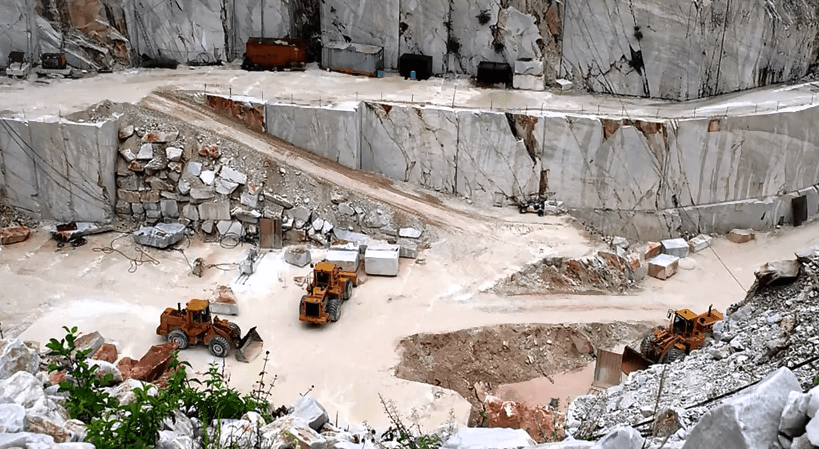First of all let’s define what we mean with surface mining. Surface mining means the extraction of mineral deposits or coal reserves or stones of different kinds that are outcropping the earth’s surface or located at shallow depth from it. The economic depth for surface mining can range from 100 metres to 1 kilometre and over. The surface mining can be classified depending on the location of the deposit or the type of mining method. Generally speaking, we can classify surface mining in three main typologies that are open pit, open cast, and quarry.
Open pit refers to the exploitation of a deposit outcropping to the surface or at shallow depths. Open pit involves the excavation of the overlying waste rock called overburden, the transportation of the waste rock to an appropriate dump the location, and the mining of the deposit. If the waste coming from the removal of the overburden is done relocated or back field on the working area, in this case we talk about open cast. In coal mining terms, we can refer as a strip mining methodology.
Finally we should do not forget that mining also includes the quarrying of soils and rocks for civil purposes. In this case, we talk about a quarry where we extract soils, crushed rock products and dimensional stones, as marbles and granites. Why should we decide to go for a surface mining instead of an underground mining method? With increase of the global demand for mineral commodities related to the increase of population and consumption per capita an efficient and economical mining method is more requested than ever before. And surface mining has its own advantages compared to the underground mining method. The advantages of surface mining include the total recovery the grade control the economy of scale, the flexibility of the operations, and the last but not least the safety of the working environment I will discuss each of them in a little bit more details.
Recovery means the quantity of material that could be extracted. In underground mining not all the mineral deposit can be extracted, because some material needs to be left on-site to support the ground above. This is not the case for surface mining where there is no ground above and all the mineral deposit can be extracted. In surface mining we have the luxury to be able to see what is going to be mined. And this allows us to see the material and be able to decide which material is going to be processed and which material is going to be wasted. In this way, we can optimise the efficiency of the mineral processing. And this is the advantage that we define as grade control.
It is generally more economical to move a volume of earth in a single load with a big machine instead of moving many loads with several small machines. The ample space afforded by an open pit means that we can move earth on a scale that is only limited by our ability to build big machines. Such economy of scale is not possible in the confined space of an underground mine. The economy of scale links directly to the next important advantage of the surface mining operations. That involved the movement of huge volumes of material. And so the restrictions that are given for example, in underground mining they are not in the surface mining operation, where there is measure, flexibility of the operations. In the same way, issue related to the restriction given by the reduction of the spaces in underground mining like the dust the poor visibility, the reduced space for personnel and machines are greatly reduced in surface mining.
All these advantages give the potential to surface mining for being an economical superior mining method over an underground mining method. But we should take into account that all of these advantages need to be strongly correlated to specific details of the deposit. And between these details, we have to take into account the geographical configuration of the area, the market, and the regional factors, the equipment availability in the area. But first of all, we should remember that it is the nature of the deposit itself that make the first decision of which is the most appropriate mining method of the deposit.
In the next topic, we will see which are the characteristics of the mineral deposits that are more suitable for surface mining operations.
https://youtu.be/hl2OXWp5-Mo
